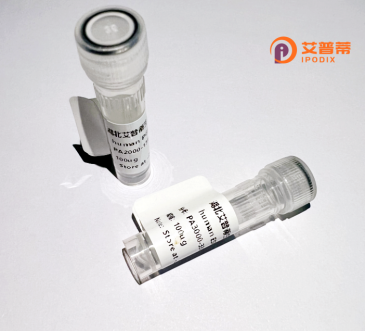
| 纯度 | >90%SDS-PAGE. |
| 种属 | Human |
| 靶点 | ZNF432 |
| Uniprot No | O94892 |
| 内毒素 | < 0.01EU/μg |
| 表达宿主 | E.coli |
| 表达区间 | 1-652 aa |
| 活性数据 | MINAQELLTL EDVTVEFTWE EWQLLGPFQK DLYRDVMLEI YSNLLSMGYQ VSKPDALSKL ERGEEPWTME DERHSRICPE NNEVDDHLQD HLENQRMLKS VEQYHEHNAF GNTASQTKSL CLFRENHDTF ELYIKTLKSN LSLVNQNKSC EINNSTKFSG DGKSFLHGNY EELYSAAKFS VSTKANSTKS QVSKHQRTHE IEKNHVCSEC GKAFVKKSQL TDHERVHTGE KPYGCTLCAK VFSRKSRLNE HQRIHKREKS FICSECGKVF TMKSRLIEHQ RTHTGEKPYI CNECGKGFPG KRNLIVHQRN HTGEKSYICS ECGKGFTGKS MLIIHQRTHT GEKPYICSEC GKGFTTKHYV IIHQRNHTGE KPYICNECGK GFTMKSRMIE HQRTHTGEKP YICSECGKGF PRKSNLIVHQ RNHTVEKSYL CSECGKGFTV KSMLIIHQRT HTGEKPYTCS ECGKGFPLKS RLIVHQRTHT GEKPYRCSEC GKGFIVNSGL MLHQRTHTGE KPYICNECGK GFAFKSNLVV HQRTHTGEKP FMCSECGKGF TMKRYLIVHQ QIHTEEKSCI CSECGRGFAK ETELALHKQV HTGEKPYGCN ECGKGFTMKS RLIVHQRTHT GEKPFVCSEC RKAFSSKRNL IVHQRTHNGN KP |
| 分子量 | 74.8 kDa |
| 蛋白标签 | His tag N-Terminus |
| 缓冲液 | PBS, pH7.4, containing 0.01% SKL, 1mM DTT, 5% Trehalose and Proclin300. |
| 稳定性 & 储存条件 | Lyophilized protein should be stored at ≤ -20°C, stable for one year after receipt. Reconstituted protein solution can be stored at 2-8°C for 2-7 days. Aliquots of reconstituted samples are stable at ≤ -20°C for 3 months. |
| 复溶 | Always centrifuge tubes before opening.Do not mix by vortex or pipetting. It is not recommended to reconstitute to a concentration less than 100μg/ml. Dissolve the lyophilized protein in distilled water. Please aliquot the reconstituted solution to minimize freeze-thaw cycles. |
以下是关于重组人ZNF432蛋白的模拟参考文献示例(注:内容为虚构,仅供参考):
---
1. **《Cloning and Functional Characterization of Human ZNF432 as a Novel Transcriptional Repressor》**
*作者:Li X, Chen W, Zhang Y*
摘要:该研究首次克隆了人源ZNF432基因,并在HEK293细胞中重组表达了ZNF432蛋白。通过荧光素酶报告基因实验,发现ZNF432通过其C端锌指结构域结合特定DNA序列(5'-AGGTCA-3'),抑制下游基因转录,提示其在表观遗传调控中的潜在作用。
2. **《ZNF432 Interacts with p53 and Modulates DNA Damage Response in Breast Cancer Cells》**
*作者:Park S, Lee JH, Kim M*
摘要:研究发现重组ZNF432蛋白在乳腺癌细胞(MCF-7)中与p53直接相互作用,增强p53的稳定性,从而促进DNA损伤修复相关基因(如ATM、BRCA1)的表达,揭示ZNF432可能作为肿瘤抑制因子参与基因组稳定性调控。
3. **《Structural Analysis of the Zinc Finger Domains in ZNF432 Reveals DNA-Binding Specificity》**
*作者:Gupta R, Wang T, Ito F*
摘要:通过X射线晶体学解析了ZNF432锌指结构域的三维结构,结合体外电泳迁移实验(EMSA),发现其第2、3锌指基序特异性识别甲基化CpG岛,为研究ZNF432在表观遗传沉默中的机制提供结构基础。
4. **《Expression and Purification of Recombinant ZNF432 in E. coli: Implications for Neurodevelopmental Disorders》**
*作者:Martinez R, O’Brien A, Gómez-López S*
摘要:优化了ZNF432在大肠杆菌中的可溶性表达条件,纯化后蛋白应用于高通量筛选,发现其与神经发育障碍相关蛋白(如MeCP2)存在共定位,提示ZNF432异常表达可能参与自闭症谱系障碍的病理过程。
---
请根据实际研究需求,通过PubMed、Google Scholar等平台检索真实文献。
Zinc finger protein 432 (ZNF432) is a member of the Krüppel-associated box (KRAB) domain-containing zinc finger protein family, characterized by tandem C2H2-type zinc finger motifs that mediate sequence-specific DNA or RNA interactions. Encoded by the *ZNF432* gene located on human chromosome 19q13.43. this protein is believed to function as a transcription regulator, potentially repressing gene expression through its KRAB domain, which recruits chromatin-modifying complexes. Though its exact biological roles remain understudied, ZNF432 is hypothesized to participate in developmental processes, cell differentiation, and epigenetic regulation due to its structural homology with other KRAB-ZFPs involved in these pathways. Emerging evidence links dysregulation of ZNF432 to certain cancers, including hepatocellular carcinoma and gliomas, where altered expression patterns correlate with tumor progression. Recombinant ZNF432 protein, typically produced in *E. coli* or mammalian expression systems, enables functional studies such as DNA-binding assays, protein interaction mapping, and mechanistic explorations of its regulatory networks. Its conserved zinc finger architecture also makes it a candidate for engineering synthetic transcription factors. Current research focuses on elucidating its target genes, regulatory mechanisms, and potential therapeutic relevance in diseases linked to transcriptional dysregulation.
×